CoinEx Token Rating Report by TokenInsight
Written by TokenInsight
Published by tokenin.cn
EXECUTIVE SUMMARY
Advantages
- The team’s overall technical background is good, and the CTO and CEO of the project have rich experience in related industries;
- The current business scope of CoinEx has been expanded, and the development of the public chain has a decisive role in promoting the development of the exchange business;
- The project operation information is transparent, and the development process is consistent with the road map;
- The unlocking schedule is clear, and the token held by the team will be unlocked continuously in the next five years;
- The project uses POS consensus mechanism. At present, it has been launched on the main network, and the block time is stable, between 2–3 seconds.
Challenges
- It is not clear enough yet whether the trichain operation planning can achieve the project’s development goals;
- There is limited information on implementation details about cross-chain and other related technologies, and the development status needs to be assessed based on the later project development disclosure information;
- The team currently hold a large share of the token, hence the distribution of tokens is relatively concentrated;
- There are few application scenarios for project tokens, and more ecosystem scenarios need to be developed;
- As a deflationary token, CET needs to be balanced by dealing with the contradiction between public chain users and token holders.
Outlook
The development of CoinEx Chain contributes to the future development of CoinEx’s centralized and decentralized exchanges; the concept of trichain operation simplifies the functions of each chain, improving their performance. At present, there are few exchanges working on the public chain, and no fierce competition has occurred.
Conclusion
Considering the status and development prospects of the project, TokenInsight gives CoinEx a rating of BB with a stable outlook.
1. Multidimensional evaluation
2. Project analysis
CoinEx (CoinEx Technology Limited) was established in December 2017 and is headquartered in Hong Kong, China. It is a sub-brand of the ViaBTC mining pool. At present, CoinEx’s business scope includes CoinEx exchange, CoinEx public chain, and CoinEx decentralized exchange. The current development focus of the CoinEx platform are public chain and exchange. The main purpose of the public chain is to build a decentralized exchange (DEX) infrastructure and an ecosystem around DEX.

CoinEx business structure,Source: CoinEx; TokenInsight
2.1 Introduction
“CoinEx Chain uses the parallel operation of three chains which are DEX, Smart, and Privacy, as well as cross-chain technologies to create a rich decentralized exchange ecosystem and blockchain financial infrastructure."
The core of CoinEx’s early business was the exchange, consisted of two major categories which were spot and derivatives trading. Currently, there are 123 trading currencies online, covering 302 trading pairs. On June 28, 2019, CoinEx released the CoinEx Chain public chain white paper, aiming to build a decentralized trading system (CoinEx DEX) with community-based operations and transparent transaction rules, and providing user-controlled asset trading scenario by the highest technical standards in the industry; CoinEx Chain has become another development focus of CoinEx. CoinEx Token (CET), which was originally a native token of the CoinEx exchange, will also be developed mainly as a built-in token of the public chain.
CoinEx Chain is a public chain based on the Tendermint consensus protocol and Cosmos SDK, and it uses POS mechanism. CoinEx Chain plans to support 42 nodes when the project starts, and any entity in the ecosystem can participate in the validator’s campaign by staking CET. CoinEx Chain will use the new block reward and the transaction fee contained in the block as the reward for running the node.
CoinEx Chain has developed three public chains with different positioning and different functions in order to meet the needs of blockchain transactions for transaction performance, smart contracts, and privacy protection at the same time. They operate in parallel and collaborate with each other through cross-chain technology. At present, the block time of the public chain is between 2–3 seconds. According to the observation of TokenInsight, the block time is stable, but the number of transactions through the CoinEx public chain is still low at present, the number of transactions in 24 hours is about 30,000; The TPS on public chain disclosed by CoinEx can reach up to 1500 per second.
CoinEx Chain uses a trichain parallel model to build a more vibrant ecosystem around DEX. The three chains are DEX public chain, Smart public chain, and Privacy public chain, respectively responsible for decentralized transactions, smart contracts, and on-chain privacy protection.
CETs that need to participate in complex financial contracts can be transferred to the Smart public chain through the DEX public chain, then moved back to the DEX public chain after that. CET tokens that need to participate in token confusion can also be carried out through the privacy transaction of the Privacy public chain, and can eventually be returned to the DEX public chain. The three public chains are responsible for their respective duties, and they are interconnected through the cross-chain technology through the relay mechanism. In addition to ensuring their respective transaction processing speed and functional attributes, they can also jointly provide richer and safer functions, and synergistically constitute the CoinEx decentralized public chain ecosystem.
In addition, CoinEx Chain also supports any participant to issue new tokens on the chain and create new trading pairs for the issued tokens. CoinEx Chain guarantees the circulation of new tokens by establishing a trading pair between the new token and CET.
2.2 Component architecture
“ Tendermint Core and Cosmos SDK have improved the performance and operation capability of the blockchain. The SDK packaging reduces the consideration of non-related logic, hence reducing the development complexity."
CoinEx Chain is based on Tendermint Core and Cosmos SDK, both of which have brought a big boost to the development of CoinEx public chain performance. Cosmos-SDK will implement the application logic of the blockchain. Together with the Tendermint consensus engine, it implements the three-layer architecture of the CoinEx public chain: the application layer, the consensus layer, and the network layer.
Tendermint
Tendermint is based on the state machine replication technology and is suitable for blockchain ledger storage. It is a list of transactions making consensus with Byzantine fault tolerance, the transactions are executed in the same order, and eventually the same state is obtained. Tendermint can be used to build various distributed applications.
Cosmos SDK
Cosmos-SDK is a blockchain framework that supports the construction of multiple assets with a consensus mechanism of POS (Proof of Stake) or POA (Proof of Authority). The goal of the Cosmos SDK is to allow developers to easily build custom blockchains from 0, while enabling the interaction with other blockchains.
Cosmos-SDK is a blockchain framework that supports the construction of multiple assets with a consensus mechanism of POS (Proof of Stake) or POA (Proof of Authority). The goal of the Cosmos SDK is to allow developers to easily build custom blockchains from 0, while enabling the interaction with other blockchains.
The blockchain development framework Cosmos SDK implements general functions such as account management, community governance, and staking in a modular form. Therefore, using the Cosmos SDK to build a public chain can simplify development procedures and facilitate operation. Tendermint is a fixed protocol in a partially synchronized environment, which can achieve throughput within a delay range of the network and each process itself. The CoinEx public chain is developed based on both, improving the performance and operability of the blockchain. The SDK packaging further reduces considerations of non-related logic and reduces the complexity of developers creating. The two components of Tendermint and Cosmos SDK are connected and interacted through the Application Blockchain Interface.
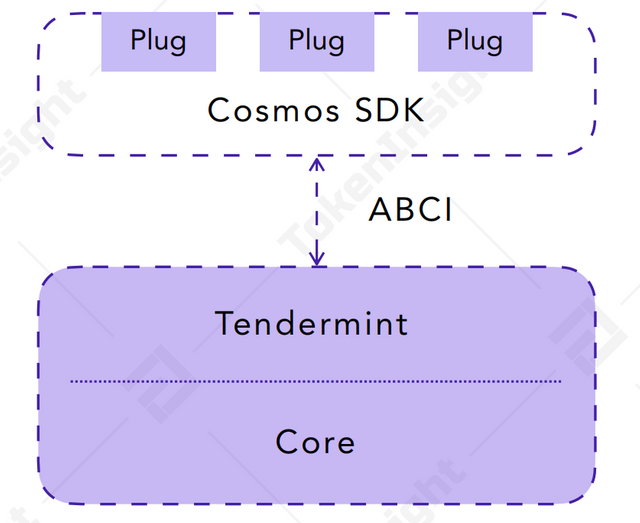
Cosmos SDK and Tendermint interworking structure,Source:CoinEx; TokenInsight
2.3 Project public chain planning
The development plan of the CoinEx public chain is to create a series of public chains with specific application directions, including:
DEX public chain: solve the problems of lack of security and opacity that are widely criticized by centralized exchanges at present; aim to build a transparent, safe, and permission-free financial platform; restore the experience of central exchanges to the greatest extent;
Smart public chain: a public chain that specifically supports smart contracts and provides a platform for building complex financial applications;
Privacy public chain: mainly provides transaction amount, account balance, and information protection and the hiding of both parties to the transaction.
In order to achieve the performance of each specific application public chain, each public chain in the CoinEx public chain focuses on the development of a certain function. For example, in order to improve the transaction processing speed of the DEX public chain, the DEX public chain only supports the necessary functions and does not support smart contracts. To achieve the smart contract function support, cross-chain connection between the DEX public chain and the Smart public chain is required.
2.4 Operation analysis
“The CoinEx platform publishes monthly ecosystem reports with high transparency; but the monthly reports are limited to contents about transactions and development, and lack progress in ecosystem and community construction, making them relatively simple."
2.4.1 Disclosure of ecosystem information
Operational risks have a direct impact on platform users. Whether platform operations are smooth and whether there is transparency are issues that platform users care about.
The CoinEx platform was established in 2017 and has around 3 years of development. It is also one of the platforms that has been developing for a long time in the exchange industry. It has obtained a digital currency trading license issued by the Estonian Financial Intelligence Unit (FIU), and the platform’s compliance is guaranteed to some degree.
The actual operation of the CoinEx platform will be displayed in the form of ecosystem monthly reports. The monthly report contains various types of content such as online currencies, new activities, plans for the next month, and ecosystem dynamics. It involves multiple business dimensions including the CoinEx exchange, CoinEx Public Chain, and CET token.
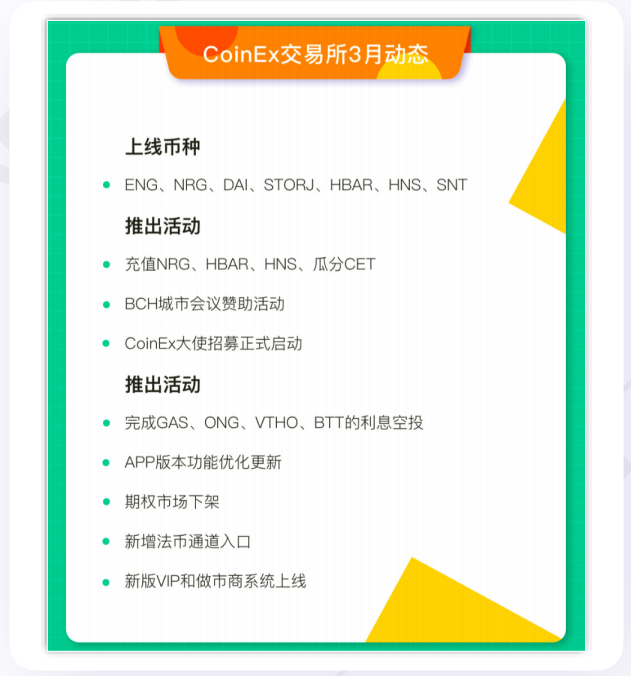
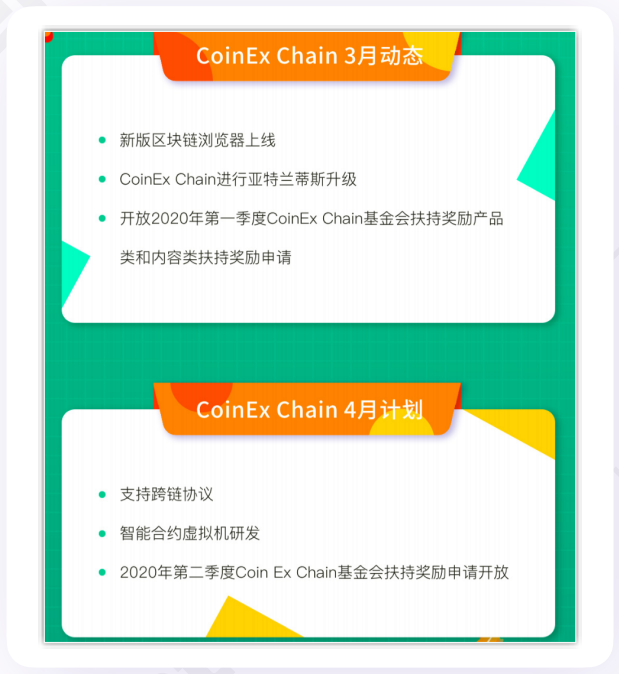
Snippet of a CoinEx ecosystem monthly report,Source: CoinEx; TokenInsight
2.4.2 Roadmap
CoinEx Chain released its development roadmap for the four quarters of 2020 in January 2020. The roadmap shows that CoinEx Chain will undergo major updates on smart contracts and DEX hard fork upgrades. The project roadmap is basically planned on a monthly basis, with a clear plan and a clear direction of development.
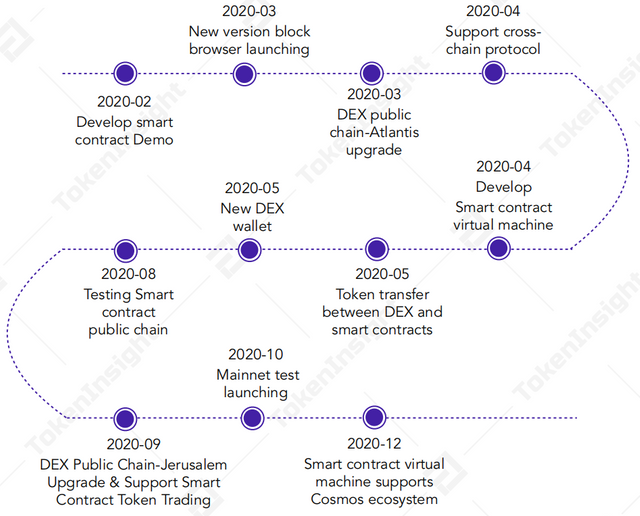
CoinEx Public Chain 2020 Development Roadmap,Source: CoinEx; TokenInsight
In addition to the development route planned in the roadmap, CoinEx public chain also discloses its goals for next month in its monthly ecological report. The project’s main net was launched online in November 2019. According to TokenInsight’s review of the development of CoinEx public chain from January to April and the disclosure of the project’s ecosystem monthly report, the project’s plan about development of the smart contract Demo in February failed to be completed as planned; the project completed launching of the new version of the blockchain browser and the Asian Atlantis upgrade; the smart contract virtual machine development was planned to be completed in April, but the progress related to supporting cross-chain agreements was not disclosed yet.
Overall, the project’s development route planning is clear, and the project’s development schedule is consistent with the plan, but there are still some discrepancies. Operation and development information is disclosed every month, and information transparency is high.
3. Industry & Competitors
The earliest origin of the exchange layout in the public chain field began in early 2018 when Binance released an announcement to start the development of the Binance Public Chain officially. In June of the same year, Huobi announced at its brand upgrade conference that it will combine the technical capabilities of the Huobi technical team and the community developers to develop the Huobi public chain called “Huobi Chain”. In December of the same year, OK Group announced the launch of its self-developed public chain OKchain, dedicating to provide underlying technical support and services for startups stationed in B-Labs.
The successful launch of the public chain brings huge strategic significance to the exchange, which can not only improve the performance of the existing business of the exchange but also achieve further expansion of its influence. As one of the most important blockchain infrastructures, the public chain can benefit the exchanges behind it.
As a platform for developing public chain technology exchanges, CoinEx’s main competitors in the field of public chain development include Binance, Huobi, and OKEx. Although they are all exchange platforms for deploying public chains, the above four are different in terms of specific functions, economic models, and critical points of the public chain.
3.1 Development progress comparison
In 2019, Binance became the first exchange to launch a public chain among all digital asset exchanges, and its main product is Binance exchange (DEX). In April 2020, Binance announced the launch of a second smart contract chain, using Ethereum’s virtual machine, so that developers can build decentralized applications without affecting the performance and functionality of their original chain.
OKEx launched OKChain’s testnet in February 2020 and completed open source two months later. OKChain is designed as the basis of large-scale blockchain-driven business applications, with the characteristics of source code decentralization, point-to-point, irreversibility, and efficient autonomy.
Huobi released Huobi Chain for the first time in July 2019, the code is open source, and the testnet was released in February 2020. As a “regulator-friendly financial blockchain”, Huobi Chain focuses on providing compliance services for companies and financial institutions.
The CoinEx public chain officially completed the main online launch in November 2019 and completed the new block browser’s launch in March 2020. On April 3, 2020, CoinEx DEX uploaded the underlying code to Github to achieve open source. The CoinEx public chain is more inclined to build a full DEX ecosystem to achieve a one-stop solution for issuing, listing, storing, and trading. The long-term goal is to create a blockchain financial infrastructure.
3.2 Comparison of economic models
At present, the exchange is more inclined to use its existing platform currency as the native token of the public chain in the construction of public chain ecology. CoinEx’s CET, Binance’s BNB, and Huobi’s HT all fall into this category. OKEx is the only exchange that issues new tokens for its OKChain, which means OKT is the only ‘inflation token’ in the exchange’s public chain, while CET, HT, and BNB are all deflationary.
3.3 Decentralization of public chain
The initial number of CoinEx public chain verification nodes is 42, which is currently the most decentralized among all exchange public chains, and able to take both efficiency and decentralization into account; OKChain also currently has a relatively high degree of decentralization in the exchange public chain (21 verification nodes), its nodes have a high degree of autonomy; by contrast, Binance still firmly controls the operation of nodes and transactions; In terms of encourages cooperation between regulators and the private financial aspects, Huobi provides a lesser degree of decentralization. Huobi Chain uses a variant of the DPoS consensus algorithm to provide functions such as “supervision nodes”, allowing regulators to become validators.
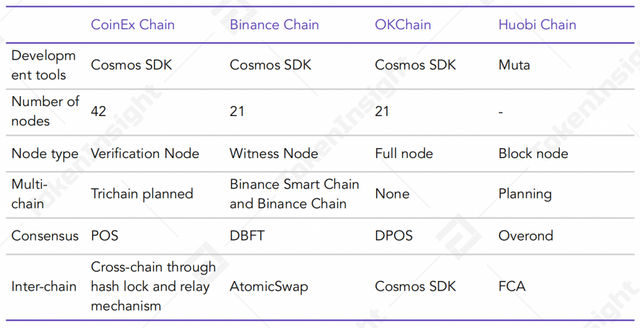
Comparison of some dimensions of CoinEx, Huobi, Binance and OKEx public chain,Source: TokenInsight
4. Token Economy
CoinEx Token (CET) is a native token of the CoinEx ecosystem. It was issued in January 2018. Token holders can enjoy some user value-added services within the ecosystem. Currently, it is mainly used as a native token on the CoinEx Chain. As of 11 am on April 23, 2020, the current circulation of CET tokens in the market is 3,215,354,906.31, with a total of 5,842,177,609.53. CET tokens will not be further issued or inflated. Currently, daily repurchase and quarterly destruction are carried out. The repurchase destruction dynamics can now be tracked real-time on the CET repurchase system on the platform.
4.1 Token Distribution
The CET token used to be based on the ERC-20 token developed by Ethereum. Since the CoinEx Chain mainnet was launched in November 2019, some ERC-20 CET tokens have been mapped to the mainnet CET, and the rest of the CET will be mapped before November 10, 2020. CET holders need to deposit ERC-20 CET to the COinEX exchange, and the exchange will conduct the main network mapping.
At present, CET is mainly circulated in the form of mainnet tokens, and only a small portion of ERC-20 CET has not been mapped. The distribution of token holdings currently circulating on the mainnet can be seen in the figure below. At present, the number of tokens held by the top ten holders accounts for about 60.44% of all mainnet CET tokens.
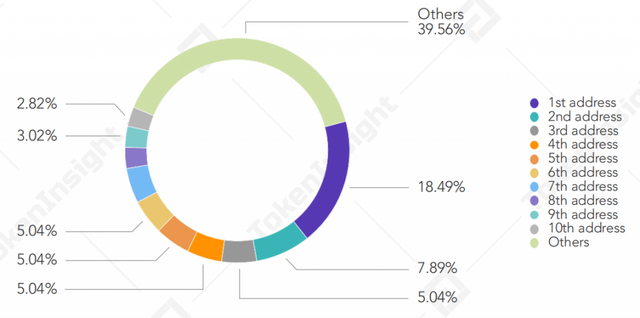
Distribution of CET token holding addresses,Source: Etherscan; TokenInsight
The following figure shows the initial distribution of tokens after the mainnet mapping preset by CoinEx. From the initial distribution map of CET, it shows that, after mapping, a large portion of CET remains concentrated in the hands of the team (31%), and the actual number of CET circulating in the market only accounts for 49% of the total.
The initial distribution of CET token,Source: CoinEx; TokenInsight
After the main net mapping, the 31% of the total CET (1.8 billion) held by the team will be gradually unlocked in the five years from 2020 to 2024, and 360 million CET will be unlocked each year. By 2024, the CET held by the team will be completely unlocked. From the current CET dynamics, the CET share held by some teams has been used for destruction purposes to achieve the purpose of CET austerity. If the frozen 1.8 billion CET held by the team are used for similar purposes, the development of CET and its platform can benefit from it.
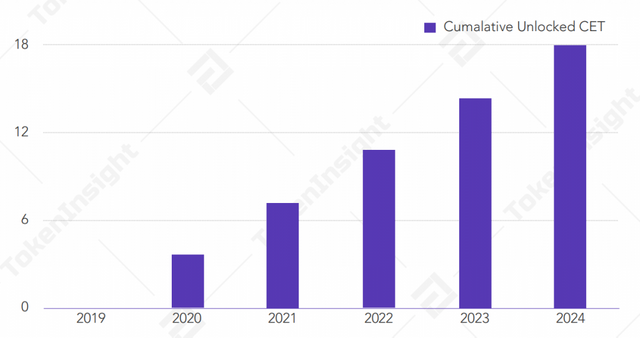
Team’s CET unlocking plan,Source: CoinEx; TokenInsight
4.2 Token economic model
4.2.1 Deflation mechanism
Since the CET token went online in January 2018, CoinEx has increased the circulation of CET through airdrops, transaction fee refunds, operation promotion, and team unlocking. As one of the existing platform coins with long development time, the deflation mechanism of CET token has undergone a series of changes with the development of the industry. In 2018, when the concept of coin-based mining prevailed, CET used transaction mining, stake mining, and pending order mining, which were cancelled in October, December and, April respectively of the following year.
The repurchase and destruction model currently used by CET was updated by CoinEx on April 11, 2020. The original CET quarterly repurchase and destruction policy of the platform will be adjusted to daily repurchase and quarterly destruction. After the implementation of the daily repurchase policy, CoinEx will take out 50% of the daily fee income for CET repurchase in the secondary market and implement quarterly destruction until the total remaining circulation is 3 billion (currently about 5.8 billion).
At the same time that CoinEx updated the repurchase and destruction plan on April 11, the platform also launched a page dedicated to displaying CET repurchase information, so that users can clearly understand the progress of CET repurchase and destruction.
As of April 23, 2020, the platform has destroyed 4,157,822,390.46 CET tokens, accounting for 41.6% of the initial total issuance. At the end of January 2019, it had destroyed 4 billion CETs (single destruction volume peak) at the end of this quarter. The number of CETs to be destroyed is 3,422,983.56.
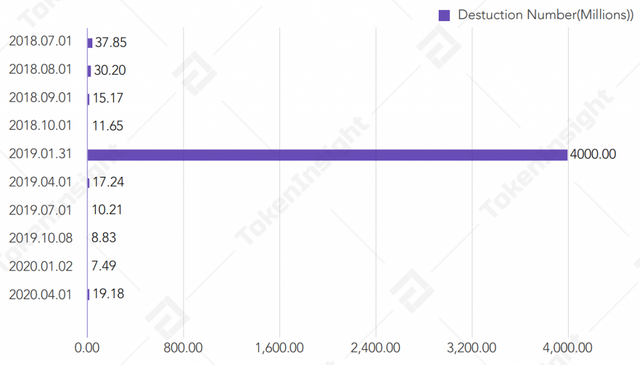
CET historical destruction data,Source: CoinEx; TokenInsight
4.2.2 Application scenarios
The current usage scenarios of CET are discounted platform transaction fees, VIP services, special activities rights and interests, CoinEx Chain internal circulation fuel, and use of external scenarios.
Deduction and discount of platform transaction fees
CoinEx platform users can use CET to deduct transaction fees when conducting transactions within the platform. At the same time, using CET to pay transaction fees can enjoy the exclusive preferential rates provided by the platform.

CET fee discount amount,Source:CoinEx; TokenInsight
VIP service
Holding a certain number of CETs can make a user become a platform VIP user. Users can also use CET to purchase platform VIPs to obtain corresponding privileges such as discounted rates, accelerated withdrawals, and exclusive customers.
Special activity rights
CET holders can enjoy special rights and interests in platform marketing activities, such as participating in the airdrop of tokens on the platform or accelerating opportunities for high-quality projects.
CoinEx Chain built-in token
CET will serve as a native token of CoinEx Chain, circulate and serve as fuel in CoinEx Chain, and users can also use CET to invest or trade other digital assets. In addition, CET can also serve as transaction fees and function fees (issuing Token, creating new trading pairs, account activation), etc. in the platform, and users can also participate in the campaign of validators by staking CET tokens.
CET is currently used as a circulation token as well for CoinEx DEX to issue tokens, create orders, Bancor, address activation, set address aliases, and other application scenarios.
In general, the types of application scenarios of CET are not plenty enough. In order to better develop the internal ecosystem of the platform, it is necessary to design and develop more CET usage scenarios and incentive mechanisms to increase the retention rate of users while adding new users.
4.2.3 Token incentive
As the native token of the CoinEx public chain, CET will be used as a block incentive to increase community participation after the mainnet of the public chain launched. The 315 million CET held by the foundation in the total CET issuance will be used to incentivize initial verification nodes and Staking participants.
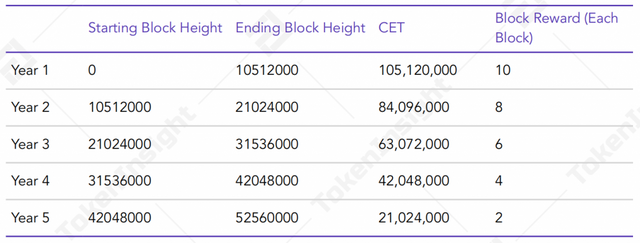
CET annual incentive information,Source:CoinEx; TokenInsight
5. Team & Partners
5.1 Core team members
Among the core team members of CoinEx, the technical members account for a relatively large proportion. The technical team’s overall ability is good and the team members have different technical experience backgrounds including cryptography, underlying protocols, marketing, and operations. The team has rich blockchain industry experience, especially the chief developer, who has about 13 years of development industry experience.
5.2 Investment institutions and partners
CoinEx’s investment is led by Bitmain and its main partners include Matrixport, Bitcoin.com, CoinBull, Consensus Lab, BTC.com, BTC.top, Hoo Exchange, Wa Yi, ChainFor.com, etc.
Investment institutions and major partners have rich experience in the industry, which can promote the development of projects to a certain extent. However, the current industry involved by the partners is not wide enough, and it will have a limited role in promoting the future of CoinEx’s enriching business lines and increasing ecosystem functions.

6. Community Analysis
According to TokenInsight’s research of the CoinEx platform community, as of April 23, 2020, its official Twitter has 19,800 followers and 932 tweets; the official Telegram has 45 official groups, 3 in Chinese and English, and the other is Korean, Arabic, Vietnamese, Indian and other small language groups, with a total number of 56088 people; the current number of followers on Facebook accounts is 3,107. The overall community followers still have a lot of room for improvement, and community activeness needs to be improved.
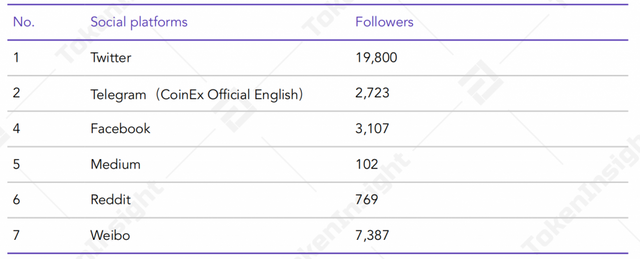
Number of followers on the CoinEx social platform,Source:TokenInsight
At present, the project’s search popularity and official website visits are both top-notch, and monthly visits have slowly returned to their previous visit levels after experiencing a significant decline in December 2019.

CoinEx visit popularity,Source: TokenInsight, Similarweb, Google
At present, the visitors of the CoinEx website are distributed in multiple countries, and there are no visits concentration from a single country or region. Therefore, CoinEx’s comprehensive global influence is widely distributed and has a reasonable degree of internationalization.
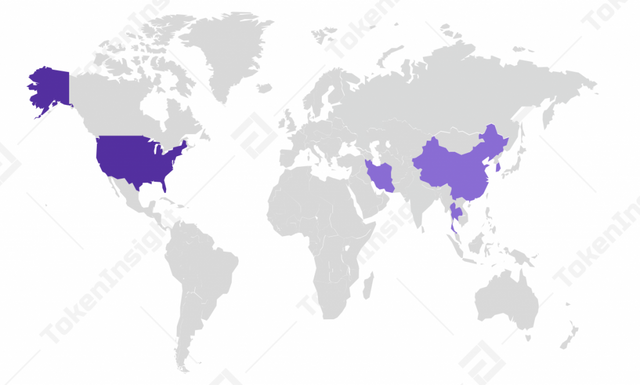
CoinEx official website’s top 5 countries by number of visitors,Source: CoinEx, TokenInsight




